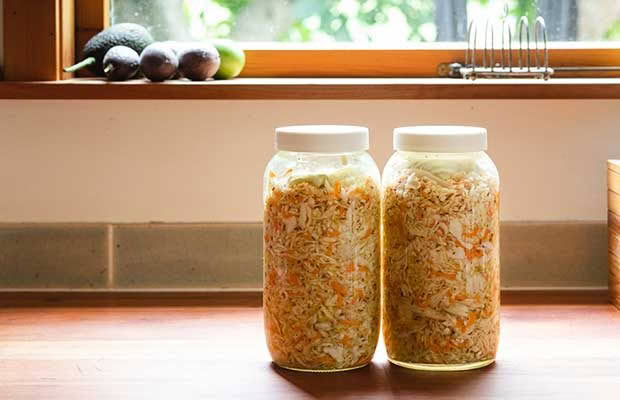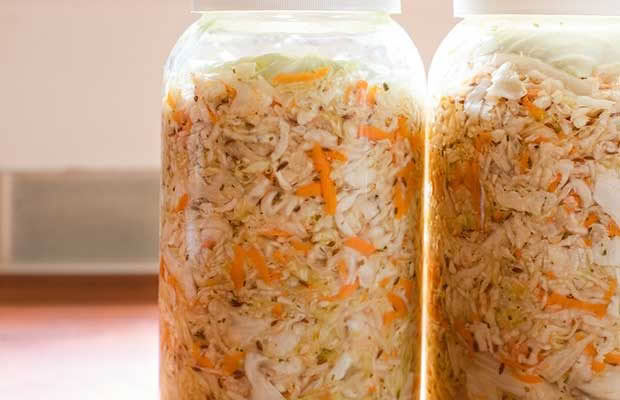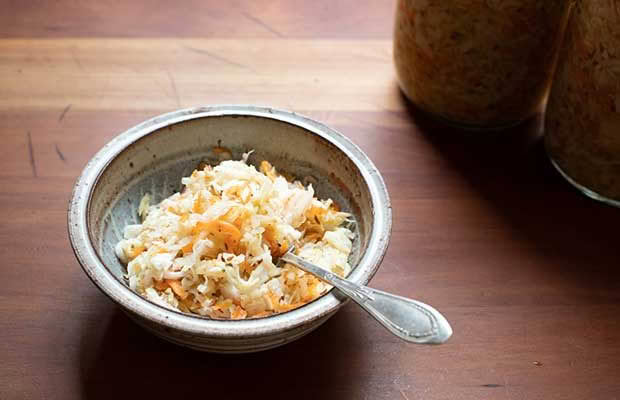Nicola Galloway: An golden-hued sauerkraut that needs a little TLC

ThisNZLife’s new food blogger kicks off her first entry with a delicious sauerkraut recipe that beginners will want to follow to the letter – and don’t skimp on the salt.
Words and images: Nicola Galloway
Welcome to my first recipe blog for thisNZlife. My focus for these blog entries will be on everyday recipes and cooking techniques inspired by the seasons. Today I share an autumnal-inspired sauerkraut with the season’s golden hues in mind.
I make sauerkraut seasonally, often taking a break over summer when there is an abundance of fresh produce around. But, come autumn I find myself craving it again. Sauerkraut, like any fermented food, takes some care and attention. If you are new to making it, follow the recipe below to the letter. The salt-to-produce ratio is the key to success, as is ensuring the produce is contained in an anaerobic (no oxygen) environment for lactic acid (lacto) fermentation to safely take place.
The biggest mistake that can be made when making sauerkraut is to have the fermenting produce exposed to air. This can happen without you knowing if brine is lost during the room temperature (rapid) fermentation. Once the rapid fermentation settles and the jars are transferred to the fridge, the liquid level can drop below the produce and unwanted microbes can set in.

The use of an additional salt brine in this recipe is a fermenting hack to keep the produce submerged at all times. And remember the salt-to-produce ratio is important. Even if you think it tastes too salty once the salt is mixed in (it is generally best not to taste it at this stage) don’t be tempted to tweak the recipe. Salt is an important part of the fermentation process and reducing it can lead to failure. With produce now at a premium price, food waste is not encouraged.
AUTUMN SAUERKRAUT WITH HONEY AND CARAWAY
Digital scales are recommended (actually, make that essential) to weigh the produce and salt. 1 tablespoon of salt weighs around 15g, but this can vary with different types of salt (fine granules vs rock) and as mentioned above can throw out that critical ratio. The addition of honey in this sauerkraut adds a warming quality (for autumn) and subtle sweet flavour. It can be left out if preferred.
Honey Salt Brine
10g unrefined salt – sea salt or rock salt
2 cups (250ml) boiling water
1 tbsp honey (optional)
Sauerkraut
1 large green cabbage – about 2kg
3 medium carrots
Unrefined salt – sea salt or rock salt
2 tsp caraway seeds
1. First make the honey salt brine. In a jug weigh the salt and add the boiling water. Leave to cool until warm to the touch, then stir through the honey until dissolved.
2. Prepare the produce. Weigh the cabbage and carrots to work out the total weight. Per 1kg of produce use 15g salt. For example if you have 2.3kg of cabbage and carrot combined use 35g salt.
3. Remove 2-3 outer leaves from the cabbage and set aside. Thinly slice the cabbage and grate the carrot. I use the slicing and grating attachments on my food processor for efficiency and even cutting.
4. Place the produce into a large bowl. Add the measured salt quantity and caraway seeds and toss to combine. Squeeze the produce for 1-2 minutes to soften so that the salt can draw out the moisture. Cover with a tea towel and set aside for 10-15 minutes. (This would be a good time to add the honey to the warm brine if you haven’t already.
5. Thoroughly wash and rinse 2-3 large jars (I use 2 litre agee jars) and air dry on a dish rack. If possible choose jars that have a wide mouth so you can fit your hand into the jar for easier packing.
6. Once the produce is ready, give it another mix and squeeze for a minute. It will be reduced in bulk considerably and liquid (brine) will be collected in the bottom of the bowl.
7. Pack handfuls of the produce firmly into the jars, using a pestle or your fist to press down evenly. Leave a 3-4 cm headspace at the top of each jar. Fold a cabbage leaf into a disk and place at the top of the jar to act as a ‘stopper’ to keep the cut produce compacted.
8. Top up the jars with the honey salt brine to come to the surface of the produce (not over the cabbage stopper). This won’t use all of the brine so pour the remaining into a jar and place in the fridge to top up the jars after the room temperature (rapid) fermentation. Secure the lids (you could use airlock lids here if you have them).
9. Place the jars onto a tray and leave at room temperature for 3-4 days. Over this time the fermentation will kick in and you will notice some bubbling in the jars. Once the cabbage colour has muted and it smells pleasantly sour, place the jars into the fridge. Check the jars after 8 hours in the fridge and if needed top up with the reserved brine to come to the surface level of the produce (again, it doesn’t need to cover the cabbage leaf).
10. Leave the sauerkraut to continue to slowly ferment in the fridge for at least 2 weeks before eating. The saltiness will reduce as the sauerkraut ages. When ready to eat, compost the cabbage stopper and use a clean fork (to prevent contamination) to scoop out the sauerkraut. Keep in the fridge and consume within 3 months.
I serve sauerkraut with pretty much everything from a dinner side, to a toastie sandwich, or a snack with cheese and crackers.

Nicola Galloway is an award-winning food writer, chef and author of five cookbooks – including her latest The Homemade Table. Nicola has been writing and photographing recipes for over 18 years, with her food focus on making the most of seasonal produce from the garden and local growers.
Nicola is also an avid sourdough baker, fermenter and preserver, and regularly teaches cooking workshops on these subjects around New Zealand. She lives in Nelson with her family on a suburban quarter acre with over 20 fruit and nut trees, vegetable gardens and free-range chooks. It is Nicola’s abundant garden that provides inspiration for the recipes she shares. Find more seasonal recipes on her website.

